Monthly economic brief: May 2021
The monthly economic brief provides a summary of latest key economic statistics, forecasts and analysis on the Scottish economy.
This document is part of a collection
Labour Market
The furlough scheme continues to provide significant support to the labour market however there are signs of improved recruitment activity as lockdown restrictions start to ease.
Coronavirus Jobs Retention Scheme (CJRS)[8]
- The CJRS has been supporting the retention of jobs and incomes since March 2020 and is currently set to remain in place until the end of September 2021.
Workforce on furlough leave in Scotland 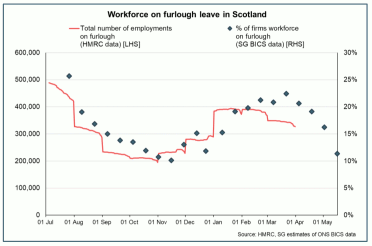
- The number of jobs supported by the furlough scheme gradually increased from October 2020 as restriction started to tighten over the winter with 373,000 jobs (15%) on furlough at the end of January during the lockdown.
- In March, 327,100 employments (14%) in Scotland were furloughed, down 41,000 since the end of February as businesses started to prepare for the easing of restrictions and is likely to decline further.
- This remains significantly higher than the low of 195,200 (8%) furloughed jobs at the end of October, however more recent Scottish Government ONS BICS data indicates that the proportion of staff on furlough continued to fall across April and into the start of May.
- The sectors with the highest number of employments furloughed across Scotland were accommodation and food services (85,560, 26% of all employments furloughed in Scotland), wholesale and retail (61,510, 19%) and arts, entertainment and recreation (27,850, 9%).
Number of Employments Furloughed by Sector (at 31 March 2021) 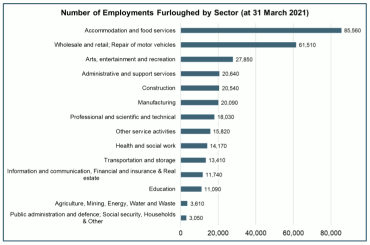
Official labour market statistics
- The latest labour market statistics for the first quarter of 2021 (January to March, during lockdown) show Scotland’s employment rate was 74.4% (unchanged over the year),[9] the unemployment rate was 4.3% (up 0.1 percentage point of the year) and the inactivity rate was 22.2% (unchanged over the year). The young person’s (16 – 24 years) unemployment rate[10] was 8.0%, down 3.9 percentage points over the year.
Scotland labour market 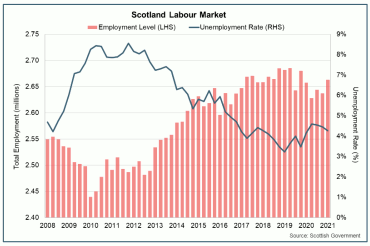
- The headline labour market indicators continue to compare well against historical trends, however only show a partial picture of the labour market as people on furlough are considered employed. Wider labour market indicators have remained relatively stable in recent months, however continue to signal challenges that have emerged in the labour market during the pandemic.
PAYE payrolled employment and Claimant Count
- The more timely Pay As You Earn (PAYE) Real Time Information data show that the number of payrolled employees in Scotland (2.32 million) and the UK as a whole (28.3 million) has fallen sharply since the start of the pandemic.
- In April, payrolled employees remained broadly stable over the month, increasing by 13,134 on a non-seasonally adjusted basis, but falling by 384 after seasonal adjustments. Overall payrolled employees have increased by 11,724 (0.5%) since November. However, compared to February 2020, the number of payrolled employees has fallen 76,358 (-3.2%) in Scotland (UK: -2.7%).[11]
Payrolled employees and Claimant Count in Scotland 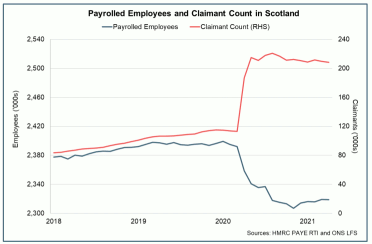
- Scotland’s Claimant Count (the number of claimants of Job Seekers Allowance and claimants of Universal Credit claiming principally for the reason of being unemployed) was 208,400 in April and decreased by 0.7% to 6.5% over the month.
- However, while the claimant count has been relatively stable since October, it remains 94,700 (83%) higher than in February 2020, signalling that the number of people that are unemployed or employed with low income and/or low hours has increased significantly during the pandemic and has remained broadly stable at this higher level since May 2020.[12]
Demand for staff in Scotland
- While the furlough scheme continues to provide significant support to the labour market, the IHS Markit RBS Report on Jobs survey for April has signalled further strengthening in recruitment activity as lockdown restrictions have started to ease and business plan for reopening.[13]
Permanent and Temporary Vacancies in Scotland 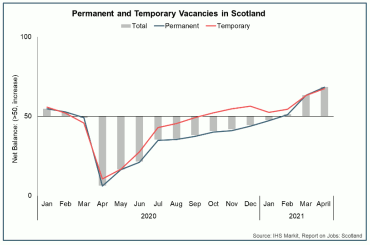
- The initial stabilisation in the labour market at the end of 2020 was driven by strengthening demand for temporary staff, however this has been accompanied by increased demand for permanent staff since February which has seen permanent staff placements increase sharply in April.
- This corresponds with ONS vacancy data for February to April 2021 which showed that UK job vacancies grew 8% over the quarter, though remained significantly lower than pre-pandemic levels. At a sector level, stronger growth in vacancies over the quarter was relatively broad based across sectors, however was most notable in accommodation and food service activities which was up 99.6% as the sector started to prepare for easing of lockdown restrictions. However vacancies in the sector remained 46.9% below pre-pandemic levels.[14]
Earnings
- Despite the protection offered to the labour market through the furlough scheme, earnings fell at the beginning of the pandemic. Between March and June, PAYE mean monthly pay fell for four consecutive months compared to the previous year. It returned to growth in July, and strengthened through the third quarter. However, earnings in Scotland have been persistently weaker than the UK during the pandemic, driven by particularly weak performance in the North East of Scotland.
- Latest data for March, suggests the rate of growth has remained broadly stable through the final quarter of 2020 and the first quarter of 2021. Mean monthly pay in March was £2,447, a 4.4% increase from March 2020, while UK annual earnings growth has eased back slightly over the first quarter to 5.2% in March.[15]
Mean PAYE Earnings Annual Growth 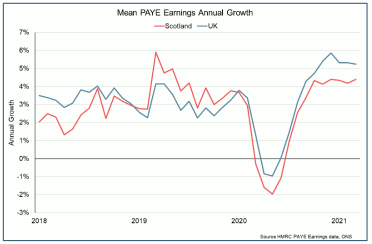
- While the mean annual earnings growth rate has rebounded in the second half of 2020, the picture is complex and caution needs to be used in interpreting the figures, particularly in light of the fall in the number of payrolled employees. There are compositional effects (e.g. by sector and across income levels) underlying the data which suggest that not all parts of the labour market have experienced the same rebound as the mean rate implies.
Contact
Email: OCEABusiness@gov.scot
There is a problem
Thanks for your feedback